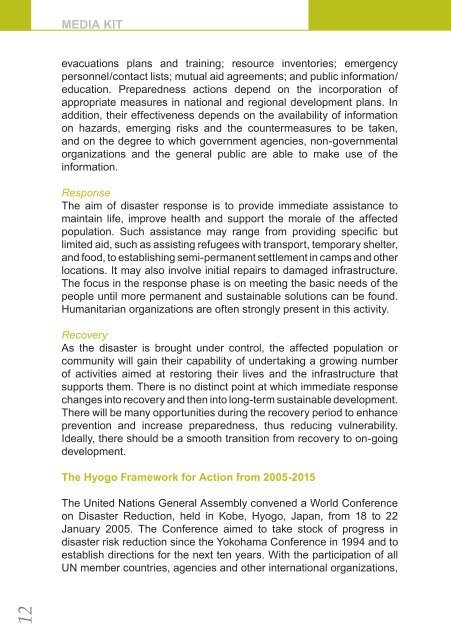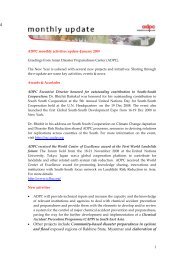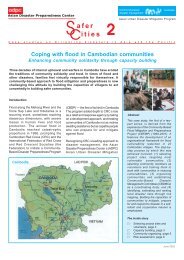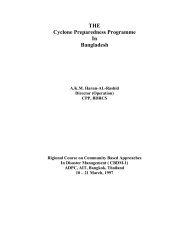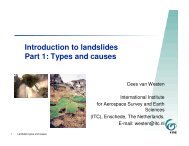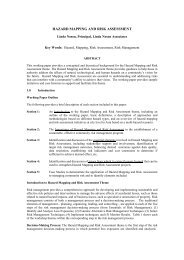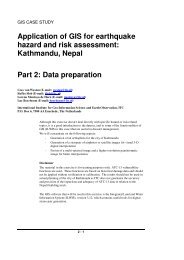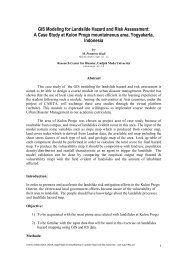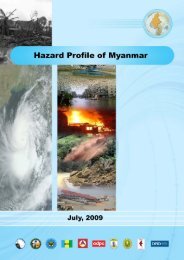community-based disaster risk management and the media media kit
community-based disaster risk management and the media media kit
community-based disaster risk management and the media media kit
Create successful ePaper yourself
Turn your PDF publications into a flip-book with our unique Google optimized e-Paper software.
12<br />
MEDIA KIT<br />
evacuations plans <strong>and</strong> training; resource inventories; emergency<br />
personnel/contact lists; mutual aid agreements; <strong>and</strong> public information/<br />
education. Preparedness actions depend on <strong>the</strong> incorporation of<br />
appropriate measures in national <strong>and</strong> regional development plans. In<br />
addition, <strong>the</strong>ir effectiveness depends on <strong>the</strong> availability of information<br />
on hazards, emerging <strong>risk</strong>s <strong>and</strong> <strong>the</strong> countermeasures to be taken,<br />
<strong>and</strong> on <strong>the</strong> degree to which government agencies, non-governmental<br />
organizations <strong>and</strong> <strong>the</strong> general public are able to make use of <strong>the</strong><br />
information.<br />
Response<br />
The aim of <strong>disaster</strong> response is to provide im<strong>media</strong>te assistance to<br />
maintain life, improve health <strong>and</strong> support <strong>the</strong> morale of <strong>the</strong> affected<br />
population. Such assistance may range from providing specifi c but<br />
limited aid, such as assisting refugees with transport, temporary shelter,<br />
<strong>and</strong> food, to establishing semi-permanent settlement in camps <strong>and</strong> o<strong>the</strong>r<br />
locations. It may also involve initial repairs to damaged infrastructure.<br />
The focus in <strong>the</strong> response phase is on meeting <strong>the</strong> basic needs of <strong>the</strong><br />
people until more permanent <strong>and</strong> sustainable solutions can be found.<br />
Humanitarian organizations are often strongly present in this activity.<br />
Recovery<br />
As <strong>the</strong> <strong>disaster</strong> is brought under control, <strong>the</strong> affected population or<br />
<strong>community</strong> will gain <strong>the</strong>ir capability of undertaking a growing number<br />
of activities aimed at restoring <strong>the</strong>ir lives <strong>and</strong> <strong>the</strong> infrastructure that<br />
supports <strong>the</strong>m. There is no distinct point at which im<strong>media</strong>te response<br />
changes into recovery <strong>and</strong> <strong>the</strong>n into long-term sustainable development.<br />
There will be many opportunities during <strong>the</strong> recovery period to enhance<br />
prevention <strong>and</strong> increase preparedness, thus reducing vulnerability.<br />
Ideally, <strong>the</strong>re should be a smooth transition from recovery to on-going<br />
development.<br />
The Hyogo Framework for Action from 2005-2015<br />
The United Nations General Assembly convened a World Conference<br />
on Disaster Reduction, held in Kobe, Hyogo, Japan, from 18 to 22<br />
January 2005. The Conference aimed to take stock of progress in<br />
<strong>disaster</strong> <strong>risk</strong> reduction since <strong>the</strong> Yokohama Conference in 1994 <strong>and</strong> to<br />
establish directions for <strong>the</strong> next ten years. With <strong>the</strong> participation of all<br />
UN member countries, agencies <strong>and</strong> o<strong>the</strong>r international organizations,


